
The xylophone is a musical instrument in the percussion family that consists of wooden bars struck by mallets. Like the glockenspiel, the xylophone essentially consists of a set of tuned wooden keys arranged in the fashion of the keyboard of a piano. Each bar is an idiophone tuned to a pitch of a musical scale, whether pentatonic or heptatonic in the case of many African and Asian instruments, diatonic in many western children's instruments, or chromatic for orchestral use.
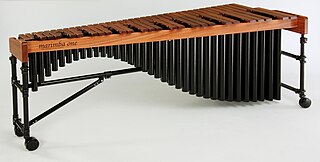
The marimba is a musical instrument in the percussion family that consists of wooden bars that are struck by mallets. Below each bar is a resonator pipe that amplifies particular harmonics of its sound. Compared to the xylophone, the timbre of the marimba is warmer and more pure. It also tends to have a lower range than that of a xylophone. Typically, the bars of a marimba are arranged chromatically, like the keys of a piano. The marimba is a type of idiophone.
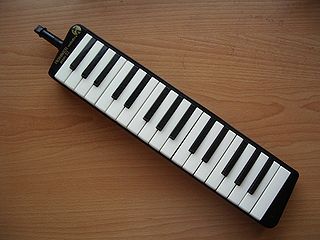
The melodica is a handheld free-reed instrument similar to a pump organ or harmonica. It features a musical keyboard on top, and is played by blowing air through a mouthpiece that fits into a hole in the side of the instrument. The keyboard usually covers two or three octaves. Melodicas are small, lightweight, and portable, and many are designed for children to play. They are popular in music education programs, especially in Asia. The modern form of the instrument was invented by Hohner in the late 1950s, though similar instruments have been known in Italy since the 19th century.
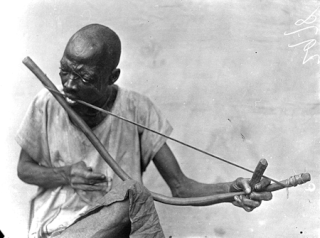
The musical bow is a simple string instrument used by a number of South African peoples, which is also found in the Americas via slave trade. It consists of a flexible, usually wooden, stick 1.5 to 10 feet long, and strung end to end with a taut cord, usually metal. It can be played with the hands or a wooden stick or branch. It is uncertain if the musical bow developed from the hunting bow, though the San or Bushmen people of the Kalahari Desert do convert their hunting bows to musical use.
Given the vastness of the African continent, its music is diverse, with regions and nations having many distinct musical traditions. African music includes the genres amapiano, Jùjú, Fuji, Afrobeat, Highlife, Makossa, Kizomba, and others. The music and dance of the African diaspora, formed to varying degrees on African musical traditions, include American music like Dixieland jazz, blues, jazz, and many Caribbean genres, such as calypso and soca. Latin American music genres such as conga, rumba, son cubano, salsa music, bomba, cumbia, samba and zouk were founded on the music of enslaved Africans, and have in turn influenced African popular music.
In music, a bow is a tensioned stick which has hair coated in rosin affixed to it. It is moved across some part of a musical instrument to cause vibration, which the instrument emits as sound. The vast majority of bows are used with string instruments, such as the violin, viola, cello, and bass, although some bows are used with musical saws and other bowed idiophones.

East Timor's music reflects its history under the control of both Portugal and Indonesia, who have imported music like gamelan and fado. The most widespread form of native folk music was the likurai dance, performed by women to welcome home men after war. They used a small drum and sometimes carried enemy heads in processions through villages; a modern version of the dance is used by women in courtship.

Xalam is a traditional stringed musical instrument from West Africa with 1-5 strings.

Developed and used by cultures living in forested areas, drums served as an early form of long-distance communication, and were used during ceremonial and religious functions.
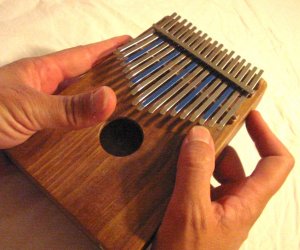
A lamellophone is a member of the family of musical instruments that makes its sound by a thin vibrating plate called a lamella or tongue, which is fixed at one end and has the other end free. When the musician depresses the free end of a plate with a finger or fingernail, and then allows the finger to slip off, the released plate vibrates. An instrument may have a single tongue or a series of multiple tongues.

A slit drum or slit gong is a hollow percussion instrument. In spite of the name, it is not a true drum but an idiophone, usually carved or constructed from bamboo or wood into a box with one or more slits in the top. Most slit drums have one slit, though two and three slits occur. If the resultant tongues are different width or thicknesses, the drum will produce two different pitches. It is used throughout Africa, Southeast Asia, and Oceania. In Africa such drums, strategically situated for optimal acoustic transmission, have been used for long-distance communication.

The music of West Africa has a significant history, and its varied sounds reflect the wide range of influences from the area's regions and historical periods.
Batucada is a substyle of samba and refers to a percussive style, usually performed by an ensemble, known as a bateria. Batucada is characterized by its repetitive style and fast pace. As is Samba, the Batucada is a Brazilian musical expression with African roots.
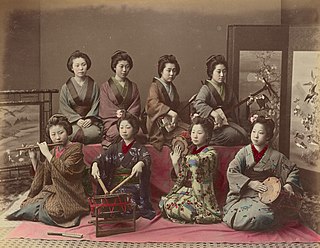
Traditional Japanese musical instruments, known as wagakki (和楽器) in Japanese, are musical instruments used in the traditional folk music of Japan. They comprise a range of string, wind, and percussion instruments.

The umuduri is a Burundian and Rwandan stringed instrument. It is a musical bow consisting of a string supported by a flexible wooden string bearer or bow that is 125–135 cm in length. The string is traditionally made from plant fiber and animal gut. However, metal wire is becoming widespread.

The Uganda Museum is located in Kampala, Uganda. It displays and exhibits ethnological, natural-historical and traditional life collections of Uganda's cultural heritage. It was founded in 1908, after Governor George Wilson called for "all articles of interest" on Uganda to be procured. Among the collections in the Uganda Museum are playable musical instruments, hunting equipment, weaponry, archaeology and entomology.
The eleaotua is a musical bow played in Guam, also spelled eluaotuas, eleaotuchan, and elimau-tuyan. This gourd-resonating musical bow likely has common roots with the Brazilian berimbau, due to constant trade between Asia and South America in the nineteenth century, during which the instrument may have been introduced to the Chamorro people. The instrument also resembles various zither/boat lutes found throughout Southeast Asia called kutiyapi.

The conservation and restoration of musical instruments is performed by conservator-restorers who are professionals, properly trained to preserve or protect historical and current musical instruments from past or future damage or deterioration. Because musical instruments can be made entirely of, or simply contain, a wide variety of materials such as plastics, woods, metals, silks, and skin, to name a few, a conservator should be well-trained in how to properly examine the many types of construction materials used in order to provide the highest level or preventive and restorative conservation.

Kurung-kurung is a traditional Banjar musical instrument originating from South Kalimantan, Indonesia. Kurung-kurung instrument is made of long wood and the bottom is made of bamboo. This musical instrument can make a sound after being pounded to the ground and the rhythm of the music released will be different from each other, to make a different rhythm, the music player will pound the instrument alternately according to the desired rhythm.














